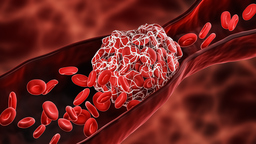ML355-sHDL as a New Delivery Mechanism for Antiplatelet Therapy Targeting 12-Lipoxygenase
TECHNOLOGY NUMBER: 2021-132
Tags:

OVERVIEW
A synthetic high-density lipoprotein (sHDL) for use as an antithrombotic agent- Diminishes platelet hyperactivity and delivers antithrombotic drug delivery
- A novel agent that shows advantageous properties compared to existing medicines
MODALITY
Intravenous (IV) nanoparticle-based drug delivery
INDICATION
Prevention and treatment of thrombotic cardiovascular events (e.g., arterial thrombosis, stroke, myocardial infarction)
PUBLICATIONS
INTELLECTUAL PROPERTY
Patent pending
BACKGROUND
Thrombosis is a serious health problem underlying several cardiovascular pathologies, including stroke and myocardial infarction. Antiplatelet agents offer a desirable approach to thrombosis prevention through the reduction of platelet reactivity. Current antithrombotic therapies include anticoagulants, which limit blood clotting, antiplatelets, which inhibit platelet activation and aggregation, and thrombolytics, which work to dissolve the thrombus once formed. However, adverse effects associated with antithrombotic agents including high risk of hemorrhagic bleeding, slow absorption, poor bioavailability, short half-life, and narrow therapeutic windows have severely limited the agents' broad application in the clinic. Given that major bleeding events are one of the greatest concerns when utilizing antithrombotic agents, the development of safer and more effective strategies to prevent vascular occlusion is urgently needed.
INNOVATION
Researchers at the University of Michigan have developed a synthetic high-density lipoprotein (sHDL) nanoparticle which holds promise in acting as an effective antithrombotic vehicle for delivery while concurrently exerting a synergistic inhibitory effect on platelet hyperactivity. sHDL infusion has previously been shown to be an effective approach to inhibit platelet activation and arterial thrombosis in both mice and diabetic patients.This novel approach enables the delivery of higher levels of drug to sites of injury or inflammation while avoiding off-target accumulation, thus achieving improved antithrombotic efficacy through synergistic effects without compromising hemostasis.
When compared to other types of nanoparticles, sHDL is advantageous because of its proven clinical safety as well as the ability to manufacture it through established large-scale manufacturing processes. Together, these factors demonstrate that the entrapment of an antithrombotic agent by sHDL provides an effective, feasible, and rapidly translatable strategy for the prevention of thrombotic events. In addition to its proven antithrombotic effect, sHDL is a biomimetic nanoparticle used to mimic the in vivo biological activity of endogenous HDL, which is well recognized as protective in cardiovascular and chronic inflammatory diseases. This invention may therefore prove effective for a wide variety of common, serious illnesses.